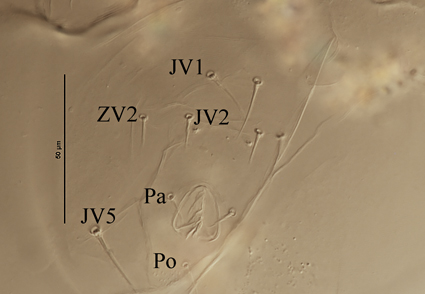Abstract
This paper describes the immature and mature characteristics of Amblyseius eharai Amitai & Swirski in detail to determine its morphological ontogeny based on laboratory-reared specimens. The main changes during ontogeny are as follows: the pronotal shield extends to j6 level and opisthosoma is unsclerotized in the larva; the dorsum has two shields in the protonymph, pronotal shield slightly expended comparing to that of the larva, and the opisthonotal shield smooth and weakly sclerotized. The podonotal and opisthonotal shields in the deutonymph are partially fused, and the dorsal shield is complete, covering almost the entire opisthonotum in adults in both sexes. There are nine pairs of dorsal setae in the larva, 14 pairs in the protonymph, and 19 pairs in both deutonymph and adult. In deutonymphs, gender could be distinguished by the number of setae in the area around the anal valves. In protonymphs, all dorsal, hypostomal setae, and the macrosetae of leg IV appear and are consistent with the subsequent stages. The development of morphological traits in the ontogeny of A. eharai may provide some basic knowledge to distinguish it from closely related species.
References
Aponte, O.R. & McMurtry, J.A. (1987) Description of the immature and adult stages of Amblyseius colimensis n. sp. (Acari: Phytoseiidae) from Mexico. Acarologia, 28(3), 201–220
Beard, J.J. (2001) A review of Australian Neoseiulus Hughes and Typhlodromips de Leon (Acari: Phytoseiidae: Amblyseiinae). Invertebrate Systematics, 15 (1), 73–158. https://doi.org/10.1071/IT99017
Chant, D.A. & McMurtry, J.A. (2007) Illustrated Keys and Diagnoses for the Genera and Subgenera of the Phytoseiidae of the World (Acari: Mesostigmata). Indira Publishing House, West Bloomfield, Michigan, 220 pp.
Demite, P.R., de Moraes, G.J., McMurtry, J.A., Denmark, H.A. & Castilho, R.C. (2018) Phytoseiidae Database. Available from: www.lea.esalq.usp.br/phytoseiidae
Evans, G.O. (1963) Observations on the chaetotaxy of the legs in the free-living Gamasina (Acari: Mesostigmata). Bulletin of British Museum (Natural History) Zoology, 10, 277–303.
https://doi.org/10.5962/bhl.part.20528
Filgueiras, R.M.C., Mendes, J.A., Neto, E.P.S., Monteiro, N.V. & Melo, J.W.S. (2020) Neoseiulus barkeri Hughes (Acari: Phytoseiidae) as a potential control agent for Raoiella indica Hirst (Acari: Tenuipalpidae). Systematic and Applied Acarology, 25(4), 593–606. https://doi.org/10.11158/saa.25.4.1
Han, G.D., Su, J., Zhang, K., Chen, J. & Zhang, J.P. (2020) The predatory mite Neoseiulus bicaudus (Mesostigmata: Phytoseiidae), a promising biocontrol agent of whitefly Bemisia tabaci (Hemiptera: Aleyrodidae). Systematic and Applied Acarology, 25 (12), 2273–2285. https://doi.org/10.11158/saa.25.12.10
Ji, J., Lin, T., Zhang, Y., Lin, J., Sun, L. & Chen, X. (2013) A comparison between Amblyseius (Typhlodromips) swirskii and Amblyseius eharai with Panonychus citri (Acari: Tetranychidae) as prey: developmental duration, life table and predation. Systematic and Applied Acarology, 18 (2), 123–130. https://doi.org/10.11158/saa.18.2.4
Li, J., Yi, T.C., Guo, J.J. & Jin, D.C. (2019) Redescription of Bryobia pritchardi Rimando, 1962 (Acari: Tetranychidae), with an ontogeny of chaetotaxy. Acarologia, 59(1), 73–110. https://doi.org/10.24349/acarologia/20194312
Li D. D., Yi T. C. & Jin, D.C. (2020) Morphological changes in Neoseiulus californicus (Acari: Phytoseiidae. Zootaxa, 4857(1), 71–96. https://doi.org/10.11646/zootaxa.4857.1.5
McMurtry, J.A., de Moraes, G.J. & Famah Sourassou, N. (2013) Revision of the lifestyles of phytoseiid mites (Acari: Phytoseiidae) and implications for biological control strategies. Systematic and Applied Acarology, 18, 297–320. https://doi.org/10.11158/saa.18.4.1
Ma, M., Fan, Q.-H. & Zhang, Z.-Q. (2018) Morphological ontogeny of Amblydromalus limonicus (Acari: Phytoseiidae). Systematic & Applied Acarology, 23 (9), 1741–1765. https://doi.org/10.11158/saa.23.9.3
Ma, M., Fan, Q.-H. & Zhang, Z.-Q. (2019) Ontogenetic changes in the morphology of Phytoseius leaki Schicha, 1977 (Acari: Phytoseiidae). International Journal of Acarology, 45(1), 56–68. https://doi.org/10.1080/01647954.2018.1544664
Rowell, H.J. & Chant, D.A. (1979) Observations on the ontogeny of setae in the family Phytoseiidae (Acarina: Gamasina). Canadian Journal of Zoology, 57(3), 670–682. https://doi.org/10.1139/z79-080
Wang, J., Xin, T., Ye, X., Huang, X., Gao, S., Zou, Z. & Xia, B. (2020) Effects of food sources on the fecundity and gene expression of vitellogenin and its receptor from Amblyseius eharai (Acari: Phytoseiidae). Systematic and Applied Acarology, 25 (1), 139–154. https://doi.org/10.11158/saa.25.1.11
Wu, W.N., Liang, L.R., Fang, X.D. & Ou, J.F. (2010) Phytoseiidae (Acari: Mesostigmata) of China: a review of progress, with a checklist. Zoosymposia, 4, 288–315.
Wu, W.N., Ou, J.F. & Huang, J.L. (2009) Fauna Sinica Invertebrata vol 47. Arachnida Acari Phytoseiidae. Science Press, Beijing, China, 510 pp.
Zhang, Y.L. (2012) An investigation of predatory mites in Gansu province and ontogenetic study on Euseius utilis Liang & Ke. Lanzhou, Gansu Agricultural University, 60 pp.
Zheng, Y., Clercq, P.D., Song, Z.W., Li, D.S. & Zhang, B.X. (2017) Functional response of two Neoseiulus species preying on Tetranychus urticae Koch. Systematic and Applied Acarology, 22 (7), 1059–1068. https://doi.org/10.11158/saa.22.7.13
Zhu, R., Guo, J.J., Yi, T.C., X R. & Jin, D.C. (2019) Preying potential of predatory mite Neoseiulus californicus to broad mite Polyphagotarsonemus latus. Journal of Plant Protection, 46 (2), 465–471. https://doi.org/10.13802/j.cnki.zwbhxb.2019.2018008

